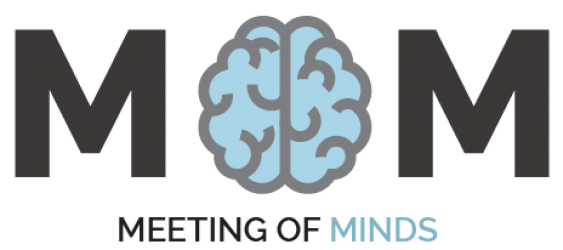Five Stages of Business Growth
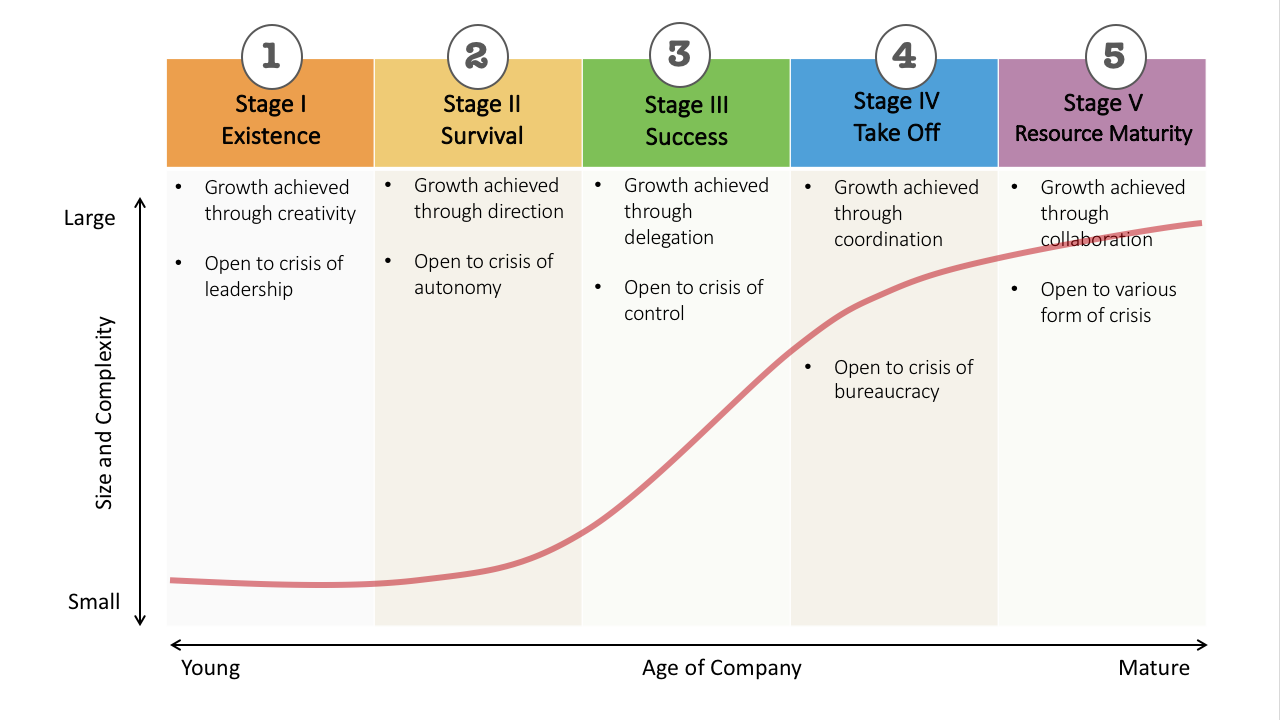
The figure by Lewis and Churchill illustrates some of the key challenges that young enterprises face as they go through various stages of growth as follow:
Value Propositions
In the recent years, the marketing games have changed as well as customer behaviours. These are the result of the invention of the wireless internet, smartphone and social media. Since social media has become popular, many enterprises use it as a tool to broadcast, advertise and promote their products. This conducts to the high level of competition among start-ups and large brands. This competition is not only effect brands provided products or services, yet also affect software developers. Many new developers launch new sites or applications every single day; there are a variety of social media platforms that users can choose what they would like to use, share their thought and spend time on. However, there is a lack in the number of social networking site or applications for academic propose. Continue reading “Value Propositions”
Our Logo and Marketing
The brand logo is the first thing that customers will think of when it comes to identifying brand. The logo represents as an identification badge, as a way to expand an enterprise’s name and as a mark of quality. Furthermore, if a logo is managed and created properly, it may result in generating competitive advantage and facilitate the task of formal corporate communications. The name of the company, logo, colour scheme and typeface are considered as the main components of corporate visual identity (CVI). Van Riel and Van den Ban pointed out the difference between the intrinsic properties of logos and extrinsic properties. Extrinsic properties are those creating from association with the organisation. It can be represented by an illustration of Nike which has powerful referential elements – they use the Swoosh standing for movement. The logo of Nike has low representativeness but high level in extrinsic value. Even though the power of extrinsic properties is high and the degree of realism in the design is contrary related to the ability to attribute additional meanings, only little studies examined whether abstract design or illustrative design is more suitable to particular companies.
Another point worth mentioning is logo colour due to its mnemonic quality in the areas of recall and recognition. Colour can play a significant role in informing information, generating lasting identity as well as advising imagery and symbolic value. According to research from WebPageFX a web design and marketing company, people judge about a product subconsciously in less than 90 seconds of viewing, and most of them base their assessment on colour alone. Moreover, nearly 85% of consumers refer colour as the primary reason when they buy products. In fact, 80% of consumers believe that brand recognition can be increased by colour.
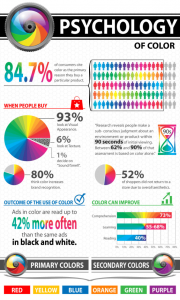 (Fast Company, 2018)
(Fast Company, 2018)
Meeting of Minds logo uses blue as the main colour because blue can result in a calming effect for whoever sees it. Naturally, blue is typically associated with the sky and the coolness of the sea which has an impact on calming the sense and lower blood pressure. Some claim that blue may stimulate a feeling of security, trust and cleanliness. In terms of marketing, blue is frequently used in cooperate business because it is productive, non-invasive and can create a sense of trust and security in a brand. For Meeting of Minds, blue is the perfect colour not only for the logo but also for our site since we are concerned about user’s privacy and security.
Our logo is created and designed as a combination mark ( a pictorial mark with a word mark ) due to the amount of versatility that a combination mark offers, it is easy to catch the eyes of specific groups in which the service or product aimed. With a combination mark, the brand will be reinforced. Using a combination mark will allow people to associate the name of the brand together with the pictorial mark straightaway. Furthermore, this combination can generate a distinct image which makes logos are easier to trademark than using a pictorial one alone.
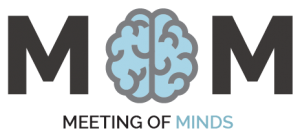
Ref:
Fast Company. (2018). What Your Logo’s Color Says About Your Company (Infographic). [online] Available at: https://www.fastcompany.com/3028378/what-your-logos-color-says-about-your-company-infographic [Accessed 1 Apr. 2018].
Morones, H. (2016). Do you know the 7 different types of logos?. [online] 99designs. Available at: https://99designs.co.uk/blog/tips-en-gb/types-of-logos/ [Accessed 2 May 2018].
Amasci Creative Limited. (n.d.). Professional Logo Design & Branding. [online] Available at: http://www.amasci.co.uk/services/logo-design-branding/ [Accessed 1 May 2018].
Hynes, N. (2008). Colour and meaning in corporate logos: An empirical study.
Business Model Canvas
Business Model Canvas was first introduced by Alexander Osterwalder. It is a tool to help people understand a business model in a structured way. What business model canvas does is enable people to rapidly sketch out the key elements of the business as well as see how different perspective of business is interrelated.
This tool is not widespread only among start-ups, but it is getting more and more popular among SMEs and marketing experts as well.
The 9 Building Blocks of business model canvas
These blocks explain different components, players and functional correlation. The model demonstrates as a figure below.
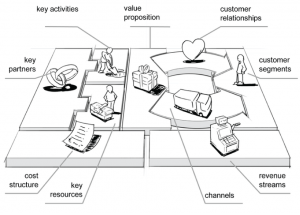
Source : https://iammoulude.wordpress.com/2014/07/02/business-development-model-of-canvas-the-9-building-block-approach/
1. Customer Segment – The target customers that companies plan to offer value with services or products. The model may define small or large customer segments. A company needs to decide which segment to severe and which to ignore. Once a company made this decision, a business model can be circumspectly designed around an understanding of specific customer needs.
2. Value Proposition – This section is generated to describe how customer segment will value and differentiate the company from competitors.
3. Channels – The organisation deliver value proposition through communication, sales channels and distributions.
4. Customer Relationship – How do organisation plan to maintain strong relationships with customer segments.
5. Revenue Streams – There are two types of Revenue Streams that a business model can be involved: transaction revenue and recurring revenues. It illustrates how will revenues be brought from target customers by value proposition.
6. Key Resources – The assets required to run the operations of the company effectively.
7. Key Activities – The essential processes that make the business successful.
8. Key Partnership – Partnerships matter since some activities are outsourced and can be obtained through networking with people outside the organisation.
9. Cost Structure – All of the costs associated with a business.
Business Model Canvas of Meeting of Minds
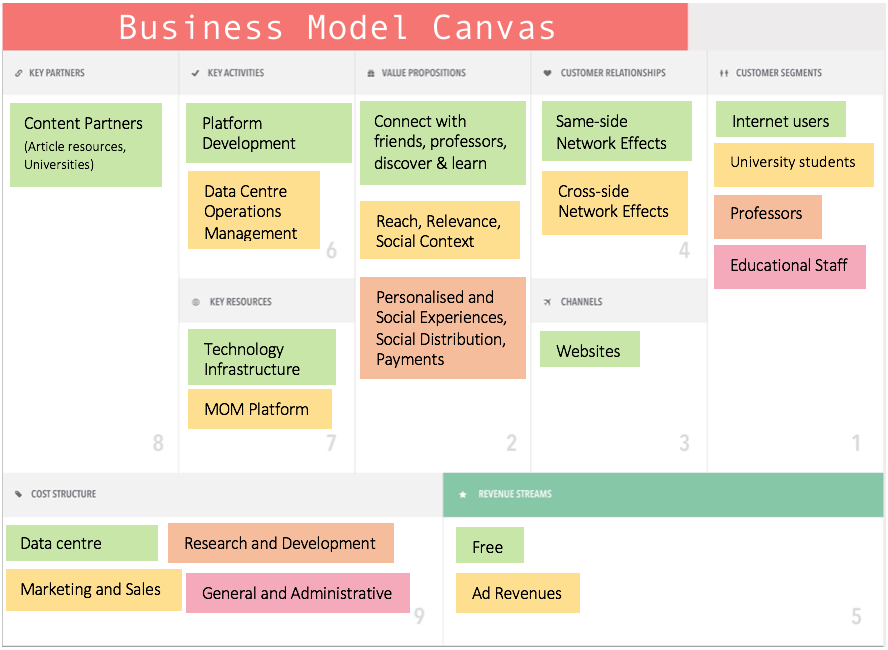
An alternative business model of MOMs
Undoubtedly, the internet has reshaped nearly every aspect of our daily life. As the world has become more and more connected through the information and communication technologies advancement, web 2.0 was introduced. Since then, online social networks (OSN) and social network sites (SNS) have appeared as a major societal phenomenon in the latest decade. It is widely known that web 2.0 technologies are versatile and affordable. With web 2.0, the services provided by the networks are conditional on content that users create. Moreover, web 2.0 is allowing users with no experience and knowledge of programming language, for example, HTML, CSS and JavaScript to transform a read-only web to a read/write web.
Social network sites have permeated internet users in all generations, and turning to a significant communication tool, especially in the student communities as it enables students to deliver instructional content and provide opportunities to connect to other students and educational staffs. These days, the number of social network site and its user are increasing rapidly as we can see from famous social media platforms such as Facebook, YouTube and Twitter, these were launched in 2004, 2005 and 2006 respectively. In fact, three of them are new platforms, but they have already reached over millions of users, besides, their valuation is counted in billions of US$. This is an astonishing development which cannot be found in any other line of business. According to those mentioned above, it demonstrates the power of network effects, where the benefit of individuals depends on the usage and presence of the network by others.
In an early age when the internet first boom, the common way businesses endeavoured to make money on the traffic was used to display or text advertising. As well as others, the Facebook business model from the beginning was based on monetising of the social network that has been generated. The number of users was more significant than an interaction between brand and a user. Consequently, Facebook could not make enough money from advertising service even though several advertisers spent their money on advertising. Therefore, Facebook changed and modified its business model in 2009. In early 2009, Microsoft turned into the exclusive provider for Facebook standard banner ads using the Microsoft ad Centre platform together with Microsoft’s digital advertising solution. Afterwards, during the late 2009 Facebook became less dependent upon the deal with Microsoft. They established to make money on their new experimental advertising efforts as well as through sales of third-party brands. Even though Facebook has proved that this revenue model works well for their business as it became the no.1 SNS advertised on ranked by display ad impressions in the US, some argue that a business model based on advertising still has some weaknesses, linked to the customer behaviour.
A supplementary source of income of Facebook can come from selling users’ information to advertisers. Obviously, there is privacy issue implicated. Nonetheless, from their aspect users’ usage patterns and information on users can be made anonymous and still comprise of high value to advertisers.
Social Network can be categorised as multi-sided platform business model. According to Jun Loayza (president of SocialMediaMarketing.com), there are five unique business models for social media: freemium, affiliate, subscription, virtual goods and advertising. These five revenue models are far better than monetising from just advertising. As an academic social network (ASN), Meeting of Minds aims to assist students to share common academic interests, profiles, preferences together with their historical studies. Furthermore, we are strongly concern about users’ privacy, so, that makes our business model different from the typical ones. Our business model will be drawn as a combination between affiliate model and advertising model because affiliate model does not require a large number of fund available, therefore, we as an affiliate marketer only need to develop our website and use it as the main advertising source. The advertising model is an online standard business model which sites can sell advertisement against the traffic. Indeed, all of these models will be done without tracking and storing private information of MOMs users.
However, an only business model cannot hit the nail on the head; thus business model canvas is used in order to fill the gaps and help us to estimate risks in investments. The business model canvas of Meeting of Minds will be illustrated in the next entry.
